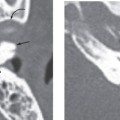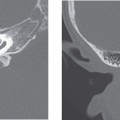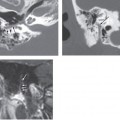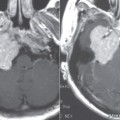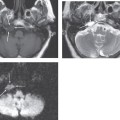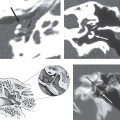CHAPTER 41 Petrous Apicitis
Epidemiology
Petrous apicitis is a rare infection of the petrous apex of the temporal bone that occurs as a result of the spread of middle ear or mastoid infection. In the past, this disease was more widespread but became much more uncommon with the introduction of antibiotics. The diagnosis may be considered in patients with a chronic suppurative ear infection that is associated with deep ipsilateral pain.
Clinical Features
The entity of petrous apicitis has become synonymous with Gradenigo syndrome. This results from advanced suppurative otitis media that spreads to the petrous apex and involves adjacent intracranial structures. The clinical findings consist of middle ear infection with otorrhea, retro-orbital pain, and a sixth nerve palsy resulting in diplopia. The sixth nerve palsy is due to involvement of the sixth nerve as it extends through the Dorello canal, which is formed in part by the petroclinoid ligament. The retro-orbital pain may be due to compression or irritation of the gasserian ganglion of the trigeminal nerve (trigeminal ganglionitis). Advanced disease may involve cranial nerves II, III, VII, IX, and X.
Patients may complain of vague or indistinct symptoms that delay diagnosis. Headaches, atypical facial pain, mixed hearing loss, vertigo, eustachian tube dysfunction, and middle ear effusion are common complaints. Facial nerve dysfunction is less common, except in advanced lesions. Hearing loss and vestibular complaints may be caused by eighth nerve involvement in the internal auditory canal or by direct extension of the process into the bony labyrinth.
Pathology
Petrous apicitis is believed to occur when organisms, typically pseudomonads, become trapped within the complex air cells of the petrous apex. The spread to the petrous apex is thought to arise from direct extension of advanced suppurative otitis media. This typically is thought to occur in pneumatized air cells; however, this is controversial. Potential complications include meningitis, cerebritis, intracranial abscess (epidural or intracerebral), and venous sinus thrombosis.
Treatment
Once the diagnosis of petrous apicitis is made, intravenous antibiotics are considered first. In severe, potentially life-threatening cases, aggressive therapy such as surgical drainage is needed.
Stay updated, free articles. Join our Telegram channel

Full access? Get Clinical Tree


